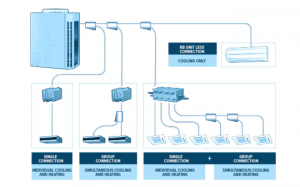Introduction
The objective of this assignment is to be able to study and practice writing techniques for definitions and peer review. In the assignment, we will choose relatively complex terms within our discipline or profession to explain to “non-technical readers” using the parenthetical, sentence, and expanded definitions.
The term “variable refrigerant flow” is typically used when learning HVAC systems or in the engineering field when selecting a mechanical system for heating and cooling a building.
The reading situation is an energy modeler is explaining the impact of a variable refrigerant flow system in a mid-rise hotel to their client.
Parenthetical Definition:
A variable refrigerant flow system ( an HVAC system that consists of outdoor and indoor units connected by refrigerant piping to provide heating and cooling to different zones in a building) is a mechanical system typically used in multi-unit residential buildings for heating and cooling.
Sentence Definition:
A variable refrigerant flow system is an HVAC system composed of outdoor and indoor units connected by refrigerant piping to provide heating and cooling to a building which one can typically see in multi-unit residential buildings.
Expanded Definition:
A variable refrigerant flow system is a heating, ventilation, and air conditioning system composed of outdoor and indoor units connected by refrigerant piping to provide heating and cooling to a building which one can typically see in multi-unit residential buildings.
A variable refrigerant flow system is also known as VRF consists mainly of one outdoor unit and the connection of many indoor units by refrigerant piping. A VRF system can provide individual zones of heating and cooling by not always running at full capacity. The units not running at full capacity saves clients energy usage and costs. VRF systems run on a heat pump system or a heat recovery system and can perform heating and cooling simultaneously. Other benefits of a VRF system include temperature control, minimized ductwork, and the need for secondary fluid sources such as chilled water loops.
Visual:

Figure 1. A diagram of a variable refrigerant flow system and how it can be customized to meet the demand of most projects.
Source: Coley , M. (2018, January 23). What is a VRF system? Top myths and facts about VRF explained. Ferguson.
Conclusion:
A variable refrigerant flow system is an efficient system that’s been used for many years. It allows the building to only operate the system when needed, resulting in more energy savings.
References
Coley , M. (2018, January 23). What is a VRF system? Top myths and facts about VRF explained. Ferguson. Retrieved from https://www.ferguson.com/content/trade-talk/tricks-of-the-trade/what-is-a-vrf-system
Jankovic, A. (2021, March 28). Back to basics: VRF Systems. Consulting – Specifying Engineer. Retrieved September 27, 2016, from https://www.csemag.com/articles/back-to-basics-vrf-systems/
Samsung. (2022). What is a VRF system? VRF | DVM S Variable Refrigerant Flow (VRF) Systems | Samsung HVAC. Retrieved from https://www.samsunghvac.com/discover-vrf
Leave a Reply